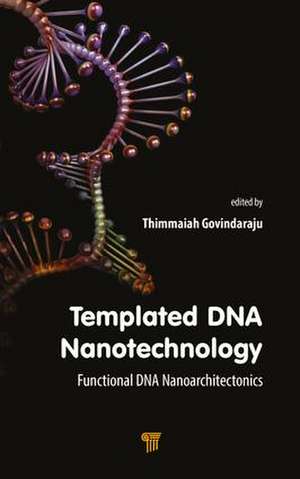Templated DNA Nanotechnology: Functional DNA Nanoarchitectonics
Editat de Thimmaiah Govindarajuen Limba Engleză Hardback – 21 ian 2019
This book discusses novel approaches adapted by leading researchers from all over the world to create functional nucleic acid molecular systems and nanoarchitectures. Individual chapters contributed by active practitioners provide fundamental and advanced knowledge emanated from their own and others’ work. Each chapter includes numerous illustrations, historical perspectives, case studies and practical examples, critical discussions, and future prospects. This book can serve as a practical handbook or as a textbook for advanced undergraduate- and graduate-level students of nanotechnology and DNA nanotechnology, supramolecular chemistry, and nanoarchitectonics and researchers working on macromolecular science, nanotechnology, chemistry, biology, and medicine, especially those with an interest in sensors, biosensors, nanoswitches and nanodevices, diagnostics, drug delivery, and therapeutics.
Preț: 1018.34 lei
Preț vechi: 1241.88 lei
-18% Nou
Puncte Express: 1528
Preț estimativ în valută:
194.89€ • 202.71$ • 160.89£
194.89€ • 202.71$ • 160.89£
Carte tipărită la comandă
Livrare economică 12-26 aprilie
Preluare comenzi: 021 569.72.76
Specificații
ISBN-13: 9789814800211
ISBN-10: 981480021X
Pagini: 444
Ilustrații: 9 Tables, black and white; 31 Illustrations, color; 113 Illustrations, black and white
Dimensiuni: 152 x 229 x 25 mm
Greutate: 0.98 kg
Ediția:1
Editura: Jenny Stanford Publishing
Colecția Jenny Stanford Publishing
ISBN-10: 981480021X
Pagini: 444
Ilustrații: 9 Tables, black and white; 31 Illustrations, color; 113 Illustrations, black and white
Dimensiuni: 152 x 229 x 25 mm
Greutate: 0.98 kg
Ediția:1
Editura: Jenny Stanford Publishing
Colecția Jenny Stanford Publishing
Public țintă
Academic and Professional Practice & DevelopmentCuprins
Multichromophore Stacks in DNA: Novel Light-Harvesting Systems. DNA-Programmed Nanoscale Assemblies of Covalently Linked Functional Monomers. Functional Molecule–Templated DNA Nanoarchitectures. Functional DNA Amphiphiles. Nucleoside Lipid–Based Soft Materials. Excited-State Dynamics in Chromophore-Appended Nucleic Acids. Templated Arrays of Multichromophores and Oligonucleotides Supported by Metal Interactions and Their Functional Relevance. Carbon Nanomaterial–Nucleic Acid Complexes and Their Biological Applications. Self-Assembled Functional Fullerenes and DNA Hybrid Nanomaterials for Various Applications. Nucleic Acid–Based Biosensors and Molecular Devices. DNA-Based Nanoswitches and Devices.
Notă biografică
Thimmaiah Govindaraju is professor at the Bioorganic Chemistry Laboratory, Jawaharlal Nehru Centre for Advanced Scientific Research, Bengaluru, India. He received his MSc in chemistry in 2000 from Bangalore University, India, and PhD in chemistry in 2005 from the National Chemical Laboratory and the University of Pune, India. From 2005 to 2006, he pursued his postdoctoral research at the University of Wisconsin–Madison, USA, and from 2006 to 2008 the Alexander von Humboldt fellowship at the Max Planck Institute of Molecular Physiology, Dortmund, Germany. Dr. Govindaraju has published more than 90 papers in peer-reviewed journals and several book chapters and holds more than 10 patents. Many of his laboratory inventions have been commercialized or licensed to develop bioimaging and point-of-care diagnostics. He is also cofounder of a start-up company, VNIR Biotechnologies Pvt. Ltd. He has received awards such as "India’s Young Blood" by Chemical and Engineering News, ACS, USA, and the Sir C. V. Raman Young Scientist Award by the government of Karnataka (2014). He is also secretary of the Chemical Research Society of India (CRSI) and the Indian Peptide Society (IPS). His research interests are at the interface of chemistry, biology, and (bio)materials sciences and include Alzheimer’s disease (disease amyloids), peptide chemistry, molecular probes, molecular architectonics,
Descriere
This book covers novel approaches adapted by leading researchers from different parts of the world to create functional nucleic acid molecular systems and nanoarchitectures. Individual chapters contributed by active practitioners provide fundamental and advanced knowledge emanated from their own work and others'.
